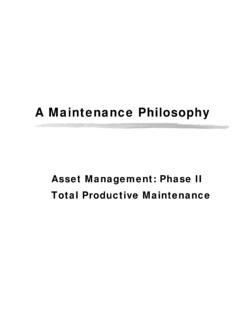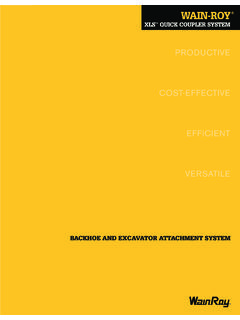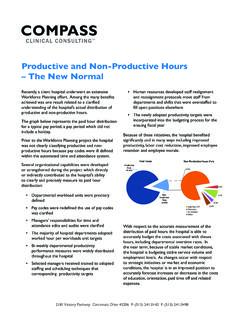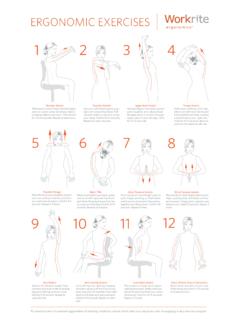Transcription of Making factories smarter, more productive …
1 Making factories smarter , more productive through predictive maintenance Avner GorenGeneral manager, Strategic Marketing, Embedded Processing & IoT lead, Texas InstrumentsMiro Adzan General manager, Factory Automation & Control, Texas InstrumentsMaking factories smarter , more productive through predictive maintenance 2 October 2016 Suppose your car could tell you when its parts are going to give you trouble, right down to the individual belt, hose, spark plug or wheel bearing. You could get parts replaced in a few minutes on an as-needed basis before they wear out and be back on the road quickly, the same way you change a set of tires today. As a result, you could save a lot of time and expense for scheduled preventive maintenance, which replaces good parts that are in use with new ones in order to prevent parts from failing while in operation.
2 Scheduled maintenance, with the car in the garage all day, might still be necessary on occasion, but less frequently and for far fewer parts. Now imagine that your vehicle is a factory worth many times the value of a car and with many times the number of working parts. Every minute the factory spends in the garage for maintenance, you pay a lot of money. You follow preventive maintenance schedules to replace parts in use that might fail, but you wish there were a better way a way to know exactly when something is going to fail so that you could replace it just in time. Most replacements would involve relatively minor maintenance and could be performed at off times, without bringing down an entire line or the factory as a practice is called predictive maintenance. Replacing or enhancing a traditional preventive maintenance schedule with innovative predictive maintenance brings savings in parts, labor and factory down time that can repay the investment many times.
3 Additionally, it can show which parts wear out faster and trigger rearrangement or redesigns that optimize machine use and the past, just-in-time predictive maintenance was largely a fantasy, but today s advanced electronics make it a reality that is rapidly increasing manufacturing productivity. Remote sensing with data transmission and aggregation, real-time communications throughout the factory, distributed control intelligence and connection to powerful data crunching and machine learning algorithms in the Internet cloud all of these function together to monitor electromechanical systems such as motors, transport systems and robots, along with field transmitters and actuators, and give warnings of probable failures that can disrupt same advanced electronic capabilities are changing other aspects of manufacturing, such as Making production lines more flexible.
4 One important effect is the ability to address requests of small-quantity orders, all the way down to a lot size of one for highly personalized products. But while many of these features of smart factories or Industry are still to come, predictive maintenance is Making its initial appearance today and can be easily installed side-by-side with existing factory control and communications who are looking to enable effective predictive maintenance require advanced integrated circuit (IC) solutions that cover every stage of data collection from the sensor to the cloud. Texas Instruments (TI) provides a range of innovative Making factories smarter , more productive through predictive maintenance 3 October 2016products designed for industrial applications, along with the expertise and commitment to bring predictive maintenance and other smart factory benefits to manufacturing plants from predictive maintenanceScheduled preventive maintenance is based on historic information concerning failure rates, information that usually combines tests by the equipment manufacturer with experience gained in the field for this specific machine, as well as similar machines deployed in similar environments.
5 Typically, if a part is known to last from X to Y hours of operation, then the part is scheduled for replacement at some time well before X hours of operation have passed to provide a significant safety margin or guard band against the possibility of failure. Parts in remote or specialized equipment are sometimes changed when technicians are on site for other reasons, even though the parts might last until the next visit if their remaining useful life could be predicted. Thus, parts are replaced much earlier and more frequently than would be required if they operated until failure, wasting some of their operational life and creating additional labor and system down time. However, these costs are sacrificed in order to avoid bringing the system down because of a part failure, which could be either a nuisance or a catastrophe, depending on the and electromechanical parts rarely fail without warning, though.
6 Every car mechanic is familiar with customers who bring in their vehicles for service because something sounds funny. Typically, changes in voltage and current supplied to a part, in temperature, vibration, sound and other symptoms give warning that the part is nearing the end of its useful life. For example, a gas detecting sensor will change its resistance over time due to temperature and aging effects. This change can be sensed, measured and used to determine when the gas sensor needs replacement. Today s electronic maintenance sensors are small and sensitive enough that they can pick up on these changes early and relay them through factory-area networks to data crunching centers in the cloud. There, complex algorithms can evaluate the symptoms and determine whether the part is close to failure and sometimes estimate how long it can operate safely before determination is likely to be based on more complete statistical information than failure rates used for scheduled preventive maintenance.
7 Instead of the hundreds or few thousands of test samples collected at product development and used to determine rates historically, cloud-based algorithms may evaluate as samples millions of parts currently in use worldwide and through their full life cycle in the field. In addition, algorithms based on multiple parameters collected from the same machine can monitor and make better-informed decisions than humans operating from limited, often imprecise information. Having more parameters may help pinpoint the problem better, too, since it may be difficult for a technician to identify exactly which part failed or is failing in a system with many parts functioning factories smarter , more productive through predictive maintenance 4 October 2016 Maintenance algorithms can be continually improved, both deliberately by people and automatically through machine learning.
8 Algorithms can be partitioned when necessary so that real-time warnings or adjustments are issued by control intelligence on the factory floor at the same time that cloud-based data crunching is working on problems that are more complex and inclusive. In addition, all of this information can feed back to parts manufacturers to help improve reliability, giving factories the benefit of more robust parts with longer operational data analysis may offer more options to management than simple replace-versus-not-replace decisions. With service information on good parts, as well as bad parts, and cost data for up- versus down-times throughout the factory, manufacturers can schedule combinations of preventive and predictive maintenance that are most cost-effective. Maintenance thus fits in naturally with the many other decisions that electronic sensing, communications and intelligence will enable in smart requirements for predictive maintenanceThe technology needed for predictive maintenance exists today and can be either designed into new production lines or retrofitted easily in existing lines.
9 Manufacturers who are looking to implement predictive maintenance need to be aware of a number of innovative technology features that make some solutions more viable than Maintenance begins with sensing, and implementations are only as good as the sensors they employ. Temperature, vibration, noise, voltage and current are among the most common forms of sensing, but certain systems may require sensing for chemical composition, spectral analysis and/or other specialized must communicate with upstream data-gathering nodes. Since sensors are often housed in hard-to-access locations, they may not be accessible through ordinary wired connections and frequently must be capable of communicating wirelessly. The same accessibility restrictions might apply for power lines, so many sensors will require long-life battery operation or some form of energy harvesting to keep going, and will have to operate on extremely low power in order to make the most of the energy include signal conversion capabilities.
10 Like the sensing element itself, signal conversion must be sufficiently fast and granular for the application. Sensors may have to be integrated with ultra-low-power microcontrollers (MCUs), as well as communications, if some amount of processing and control is to be handled locally. For example, MCUs, and other sensor electronics, might have to provide set up and provisioning functions, sensor calibration, data aggregation and storage, data filtering or pre-processing to minimize communications and other such functions. Small spaces that are difficult to access may demand that multiple types of sensing be available in a single package. Advanced integration of widely different types of functions is the key to fulfilling these Predictive maintenance senses, pre-processes and reports on real-time conditions, so communications have to operate with fast signaling and minimal latency, which in many applications are specified by industrial standards.


















